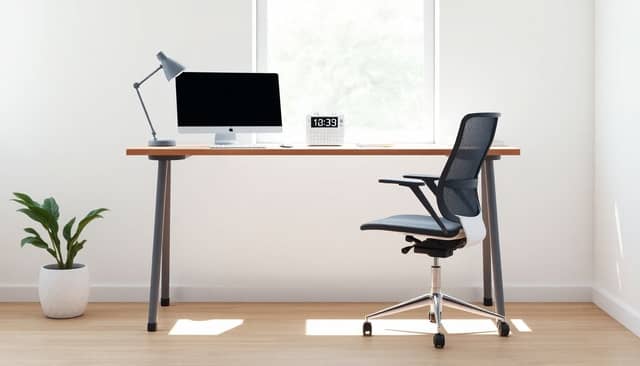Table of Contents
Choosing between sitting and standing while working at a desk is something many writers think about, especially since it can affect comfort and health. If you're tired of feeling stiff or worried about long-term health, this might be a good time to rethink your setup. Keep reading—because there are simple ways to make your writing routine more comfortable and productive, whether you prefer sitting, standing, or a mix of both.
In this guide, you'll find practical tips on how standing or sitting can enhance your focus, the importance of switching between the two, and how to set up your space so it works for your body. Got a few minutes? By the end, you'll have a clear idea of how to create a writing spot that's easy on your body and boosts your creativity.
Key Takeaways
Key Takeaways
- Standing desks are better for health because they promote good posture, reduce back pain, and boost energy, but sitting still can cause health issues. A sit-stand desk that moves between both options is ideal.
- Standing can help you write faster and keep you alert, but it may lead to tiredness. Alternating between sitting and standing keeps you comfortable and maintains productivity.
- Switching between sitting and standing every 30 minutes prevents fatigue. Use timers or reminders to make this easier, and take short movement breaks to stay energized.
- Set up your desk correctly: keep your monitor at eye level, use ergonomic accessories, and adjust your height. This helps avoid strain and makes writing more comfortable.
- Pay attention to how your body feels. Adjust your routine and workspace as needed. Trying different postures and routines will help find what works best for your health and writing flow.

1. Which Desk Type Supports Better Health for Writers?
Standing desks are often touted as healthier options for writers because they promote better posture, reduce back pain, and increase energy levels. According to recent studies, users of standing or sit-stand desks experience 50% less lower back discomfort compared to traditional sitting setups .
While sitting desks provide comfort and are easier for long-duration tasks, prolonged sitting is linked to health risks like heart disease and diabetes .
Choosing the right desk type depends on your health needs, but the best bet is a sit-stand desk that allows easy toggling to avoid the drawbacks of both extremes.
2. How Does Standing or Sitting Impact Writing Productivity?
Research shows that standing desk users often type more words, though they may make more typos, likely due to increased alertness and movement .
Call center employees standing during shifts were about 45% more productive, and productivity can increase by over 23% within a month of switching to a standing desk .
Standing encourages mindful time use and task toggling, which helps reduce boredom and procrastination common with continuous sitting .
However, standing for long periods can cause fatigue, so alternating between sitting and standing is the key to maintaining consistent productivity without discomfort.

3. Why Alternating Between Standing and Sitting Is Best
Switching between sitting and standing helps prevent fatigue and discomfort, making your writing session more sustainable.
Experts recommend aiming for a 1:1 or 1:2 ratio—for example, sitting for 30 minutes and then standing for 30 minutes—so your body isn’t stuck in one position.
Using a timer or reminder app can be helpful to prompt frequent changes, especially during long writing stretches.
Listening to your body’s signals is key—if your legs or back start to feel strained, it’s time to change position.
Incorporate short movement breaks, like stretching or walking around, which boost circulation and keep your mind alert.
4. Practical Ways to Use a Standing or Sitting Desk Effectively
Start by adjusting your desk height so your elbows are at a 90-degree angle when typing, reducing strain on your wrists and shoulders.
Invest in an anti-fatigue mat for standing sessions; it reduces pressure on your feet and legs while helping maintain comfort.
Use ergonomic accessories like a monitor riser, keyboard tray, and supportive chair to maintain proper posture regardless of your position.
Plan your writing routine around natural energy levels—tackle heavy editing in the morning when you're most alert, and lighter tasks when energy dips.
Experiment to find what works best—some writers prefer short bursts of standing, while others find longer intervals more productive.
5. Common Challenges with Standing and Sitting Desks and How to Avoid Them
One of the biggest issues is back and neck pain from poor posture—using ergonomic setups can help keep your spine aligned.
Standing for too long causes fatigue and swelling; take regular breaks and shift your weight or move around.
Prolonged sitting leads to tight hips and poor circulation—incorporate movement into your routine with brief strolls or stretching.
Many people slouch or lean forward, which strains the neck and shoulders—use adjustable desks and monitor placement to promote good alignment.
Overcoming temptations to stay in one position takes discipline—set reminders to change posture every 20-30 minutes.
6. Tips for Setting Up Your Desk for Comfort and Efficiency
Position your monitor at eye level so you don’t have to tilt your head down or up, reducing neck strain.
Keep your keyboard and mouse close enough so your shoulders stay relaxed; avoid reaching forward.
Adjust your desk height or use a desk riser to ensure your forearms are parallel to the ground when typing.
Use a footrest or an anti-fatigue mat for standing to support proper posture and comfort.
Arrange your most frequently used tools within easy reach to minimize unnecessary movement and maintain flow.
7. Final Advice: Finding the Right Balance for Your Writing Routine
The key is to listen to your body and modify your setup based on how you feel during writing sessions.
Set clear goals for each work session—whether you aim to write a certain number of words or complete specific tasks—while varying your posture.
Remember, consistency is more important than perfection—small adjustments over time lead to better health and productivity.
Try different techniques, like using timers or changing your environment, to discover what makes writing most comfortable and effective for you.
Keep experimenting until your routine feels natural—your body and mind will thank you for it, and your writing will improve as a result.
FAQs
Standing desks often promote better posture and movement, reducing discomfort. Sitting desks are familiar and comfortable, but prolonged sitting can cause issues. A combination of both suits best for maintaining health during writing sessions.
Standing can boost alertness and energy, potentially increasing output. Sitting may allow for more focus and detail work. Alternating between the two can keep you comfortable and prevent fatigue, supporting steady productivity.
Switching between standing and sitting reduces strain, improves circulation, and prevents stiffness. It helps maintain comfort and focus during long writing periods, making your routine more sustainable and less tiring.



